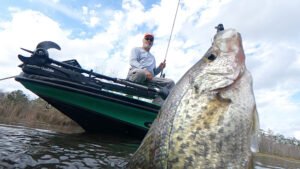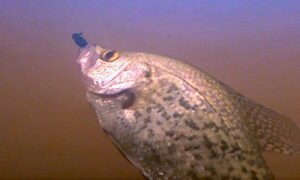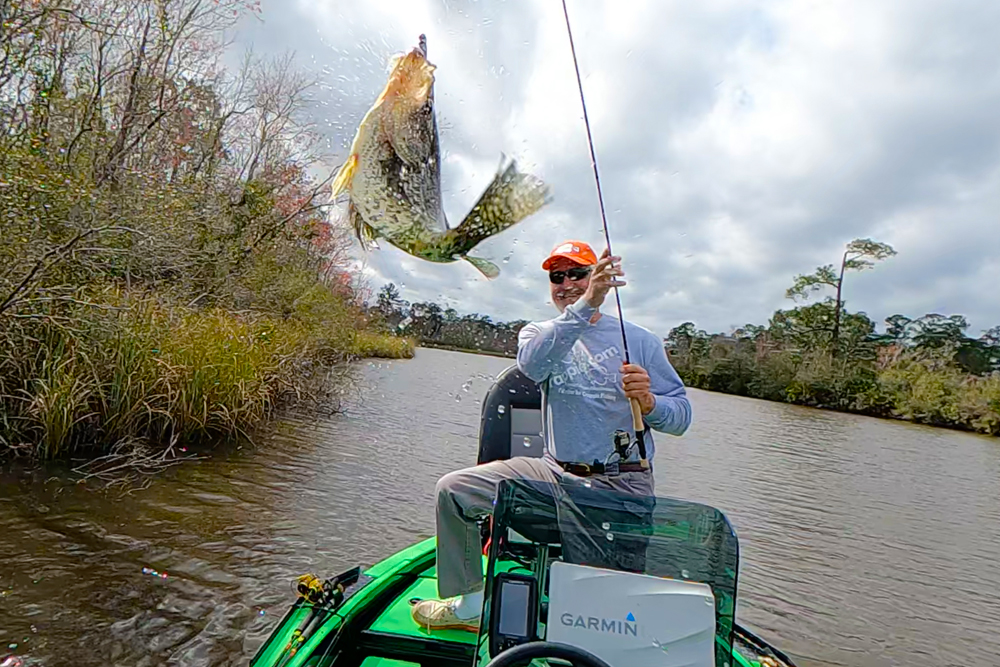Guillot sends this sac-a-lait airborne after enticing it away from
the school by “fishing above the fray”. (Photo: Keith Lusher)
Don’t want to spook the school?
By Keith Lusher
Picture the scene… You’re pulling up to one of your most productive spots. As you approach, your fish finder screen lights up, showing a large school of sac-a-lait holding at the top of a root ball 15 feet deep.

You lower your jig into the school and a fish immediately inhales it. You repeat easily the process five more times and then bite stops – even though your electronics show you the fish are still there.
For most crappie fishermen this is not and unusual occurrence. However, John Guillot of Kiln, Mississippi utilizes a method that he says can solve the problem.
Guillot is a huge proponent of using “situational awareness” to improve on the water. “Situational awareness” is frequently taught by self-defense experts as a means to see and avoid potentially dangerous situations.
Guillot says, however, similar keen awareness will allow a fisherman use more stealth when spooky fish demand it. His method – fishing above a concentrated school of fish -came about admittedly by accident when he started noticing sac-a-lait biting his jig before he was even ready to fish.
“I’d grab my pole and tie a jig on then set the rod down on the bow with the jig in the water,” Guillot said. “Sometimes the jig would hang down into the water while I got situated. Well, every once in a while, I’d see the tip bob up and down and I’d grab it only to realize that there was a sac-a-lait on the other end.”
While Guillot said it didn’t happen often, but it did pique his interest enough to try out a different technique.
The theory is quite simple: Instead of lowering the jig right into the school of fish, Guillot stops his jig about 8-10 feet above the group.
“Usually there’s at least one aggressive fish that will come up and tag it,” he said. “I started doing this and found that on almost every trash pile that I stopped at, I was catching two or three fish before I even got (the jig) down to the main group.”
By doing this Guillot was expanding his window of catching fish before the bite would shut down.

“Nothing shuts down the bite like hooking a fish and letting him thrash around down there,” he said.
I made a trip with Guillot and witnessed his technique firsthand. The East Pearl River serves as the state border between Louisiana and Mississippi. It originates in Neshoba County and runs through Ross Barnett Reservoir in Mississippi.
Our destination was a place called Steamboat, located near Logtown, Miss. Guillot said the name “Steamboat” probably originates from a sunken steamboat in the area since the log town was full of boats that docked there to escape the flow of the main river.
Because Neshoba County was “Dry,” the boats also served as floating bars for the workers. Today there are still pilings in the water that were used to secure the boats.
As we approached our first spot, Guillot lowered his trolling motor and eased the boat up to a spot about 20 feet off the bank. There was a tree canopy on the bottom that was holding a large group of sac-a-lait. The fish were suspended at 12 feet. Guillot lowered his jig about 4 feet down and then stopped and waited. When no strike came, he lowered the jig down a couple more feet and I could see watched as his rod tip twitch. He set the hook and quickly hauled the sac-a-lait over the gunwale.
![In this screen capture of Guillot’s electronics, you can see a crappie pulling away from the main school to take a jig fished “above the fray.” [Don't Spook Your Crappie]](https://crappienow.com/wp-content/uploads/10012023_above_fray4-116x200.jpg)
As the day wore on, the heat kicked in and our results diminished. However, Guillot and I continued the method of “fishing above the fray,” and it consistently worked.
Guillot said he has been fishing that way for more than 20 years – so long it has simply become second nature, programmed into his psyche.
“Presenting the lure this way just happens without a conscious thought about it,” he said.
This month Guillot said the East Pearl River is transitioning into a fall fishing pattern with the cooling water temperatures.
“Depending on how fast the water cools in October sometimes you can see your jig 6-7 feet down. The active fish being as competitive as they are, will rise the fastest during October, smokin’ any jig they see,” he said.
In addition to picking off extra fish by consciously taking a top-down approach, Guillot uses different colored jigs to keep the bite alive.
“A good single-pole crappie angler with exceptional presentation skills can limit out inside four hours, Guillot said. “In Louisiana that’s 50 crappie (no size limit). So, for us, October is hammer time.”
Keith Lusher is an award-winning outdoor journalist from Covington, Louisiana. He owns and operates NorthshoreFishingReport.com and other outlets. He serves on the board of the Louisiana Outdoor Writers Association. Lusher contributes to numerous publications both online and in print and prides himself on promoting South Louisiana’s unique fishery.


